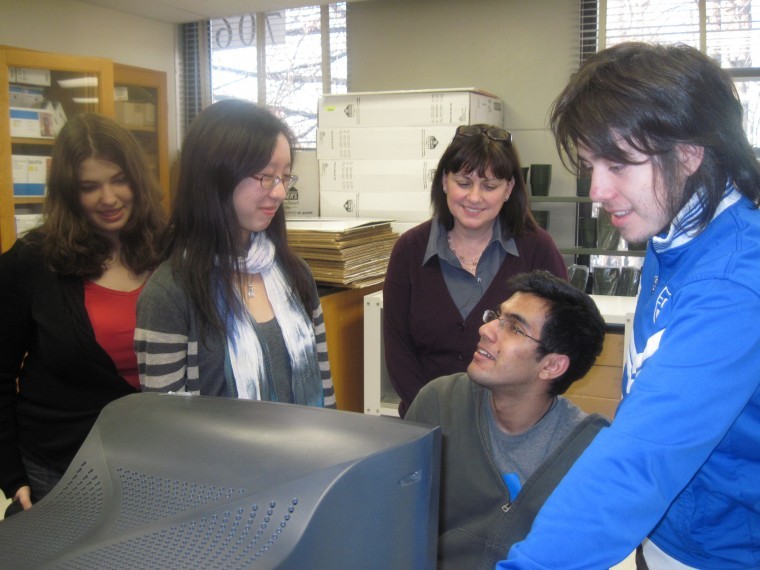
Three Herricks High School seniors have been recognized as semi-finalists in the annual Intel Science Talent Search, with a shot at making the finals of the competition later this month.
The three students – Julie Chang, Neil Pathak and Edward Vargas – were among 15 Herricks High students who submitted the requisite lab research, research papers and essays to apply for the contest.
Vargas’s project was to study the possibilities of being able to identify brains that exhibited the deformed shapes that characterize aspects of brain structure in schizophrenics. He compared two analysis methods in a magnetic resonance imaging tool for shape analysis called Spherical Harmonics-mat.
“Schizophrenia was probably the diseases that interested me most of what they worked with there since there’s so little known about it. Shape analysis seemed very promising for an investigative angle,” Vargas said.
Vargas conducted his research over two months this past summer after undergoing a period of training at the Psychiatry Neuroscience Laboratory in Boston, Mass.
The results showed that one of the Spherical Harmonics-mat formats called Iterative Point Index could successfully detect variations of more or less than two millimeters for protrusions in the brain and variations of more or less than four millimeters in the brain, Vargas wrote in his abstract on the project. He said that it confirmed prior research that indicated the validity of the method as a neuroscience tool.
Renee Barcia, science research teacher at Herricks High, said the students’ research was admirable for its real-world applications. In Vargas’s research, she pointed out that along with detecting signs of schizophrenia, the MRI imaging could aid in early detection of brain tumors.
Vargas said he was “very proud to share the glory with two other Herricks students.”
“It feels really surreal. I never thought I’d get this far,” said Julie Chang, who worked on comparative ultrasound methods to evaluate osteoporosis.
She and Pathak estimated that they had logged 40 to 50 hours per week in conducting their research as Simons Fellows last summer at the Department of Biomedical Engineering at Stony Brook University. That was the same routine that Vargas said he maintained in Boston.
“It feels like our hard work paid off,” said Pathak, who added that he was “humbly proud.”
Pathack studied the effectiveness of using single-walled carbon nanotubes – tiny microscopic structures – for precisely targeted chemotherapy and radiothermal therapy to destroy cancer cells. A specialized form of fluorescent microscopy was used to evaluate the impact of the nanotube delivery system in attaching the therapeutic substances to cancer cells.
His objective was “to create time-efficient delivery system, and his research indicated the novel drug delivery system of the nanotubes could be effective, based on three combinations of chemicals he used in the lab work.
Pathak, who will be attending Yale University next year, is aiming for a career as a doctor, either as a physician or as a researcher. His father, Naveen, and his mother, Isha, are both internists.
Vargas, who has been accepted at the Massachusetts Institute of Technology, said he aspires to work in research. His mother, Yvanka Pachas, is a psychiatrist.
Chang is considering a career in bioengineering or biotechnology. Her parents, Lisa and Joe are both physical therapists.
Chang’s project explored the potential for quantitative ultrasound treatment as an alternative to X-ray treatment. Its potential is not well understood because knowledge about the behavior of ultrasound waves is lacking. She used qualitative ultrasound machine to measure the effects of broadband ultrasound attentuate and ultrasound velocity as methods to evaluate the structural properties of bone. Her research showed that understanding the interaction of ultrasound with bone will enable clearer interpretation of results from that technology for more effective diagnosis of osteoporosis.
Apart from her scientific interests, Chang is an accomplished young musician who plays violin in the Herricks High School Chamber Orchestra. She’s also been playing piano as long as she’s been taking violin lessons, since she was five years old.
Pathak plays tennis and said he has a strong interest in writing. He is currently editor-in-chief of the Herricks High School student newspaper, the Highlander.
In his spare time, Vargas enjoys reading the works of various philosophers.
“I think it’s always good to keep a healthy balance,” he said.
All three said they were cramming to meet their respective research papers cooperatively as the deadline loomed, and the sense of camaraderie between the three was evident as they spoke about that experience.
All three agreed that the Herricks High School science research program gave them a good grounding for their Intel lab projects.
“It’s outstanding work,” Bracia said, adding that the three had conducted graduate school level research. “They’re motivated, talented, dedicated science students who’ve been able to take on challenging work. They’ve fulfilled their potential.”






